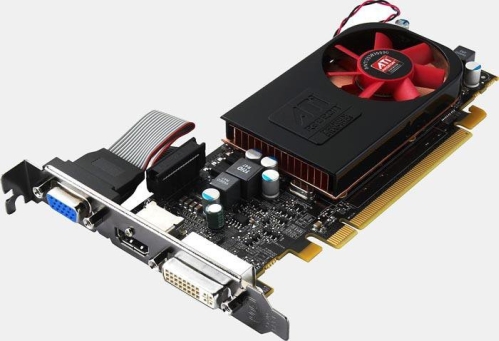Index
Page 1 of 8

Review: Superb performance for HTPCs
This review is also available in German.
Only a few days after launching the Radeon HD 5450, it’s time for HD 5570. Both cards are low end, but the numbering scheme is quick to show that the HD 5570 will be the faster of the two. These two cards belong to the HD 5000 series and are here to nicely fill out the price segments of DirectX 11 graphics market. All the HD 5000 series cards support DirectX 11, ATI Eyefinity technology for multi-monitor setups (more than 2, of course), ATI Stream GPU processing, are built in 40nm, etc.
Radeon HD 5570 is based on the Redwood GPU, one of the GPUs in the Evergreen generation. It’s well worth noting that AMD is the first and, unfortunately for the green team, the only company with DirectX 11, Windows 7 compatible hardware. Starting from the fastest GPU, the Evergreen series features Cypress, Juniper, Redwood and Cedar GPUs.
The HD 5450, which was announced last week, is based on the Cedar GPU and filled out the HD 5000 gap in €40-50 price range, but there’s still a small gap left up to the HD 5670, which is priced at €60-99. So, the new Radeon HD 5570 with its price of €50 will most certainly fit in nicely.
The HD 5570 doesn’t share too many common features with the HD 5670, despite using the same Redwood GPU. The new HD 5570 comes with lower memory and GPU clocks and uses cheaper, DDR3 memory whereas the HD 5670 has GDDR5. Both cards use 128-bit memory interface unlike the HD 5450 which has 64-bit interface.
The HD 5570 is significantly faster than the HD 5450 despite the fact that the price difference is not that big. While the HD 5450’s GPU features only 80 stream processors, 4 ROPs and 8 texture units, the HD 5570’s GPU comes with 400 stream processors, 8 ROPs and 20 texture units, just like on the HD 5670.
The HD 5570’s GPU runs at 650MHz whereas the memory is at 900MHz (1800MHz effectively). Compared to the HD 5670’s 775MHz GPU and 1000MHz memory (effectively 4000MHz), it’s evident that the new HD 5570 is a bit slower.
Lower clocks mean that the HD 5570 consumes less power – 42.7W maximum (HD 5670’s TDP is at 61W). Idle consumption is only 9.69W, and all these numbers show that the card needs no additional power connectors.
Unlike the HD 5670, the new card comes with a low-profile PCB, which is somewhat expected considering the low consumption and low temperatures. A small active but low profile cooler is in charge of cooling.
The HD 5570 comes with three video outs and one of those being DisplayPort means that the card will support ATI Eyefinity technology for three monitors. Of course, there’s also DXVA (DirectX Video Acceleration) support, HDMI 1.3a, Dolby TrueHD, DTS master audio, etc.
The following picture shows the reference HD 5570. Sapphire HD 5570, which our test sample today, runs at reference clocks and is almost identical to the card you see below.

Prev Next »
